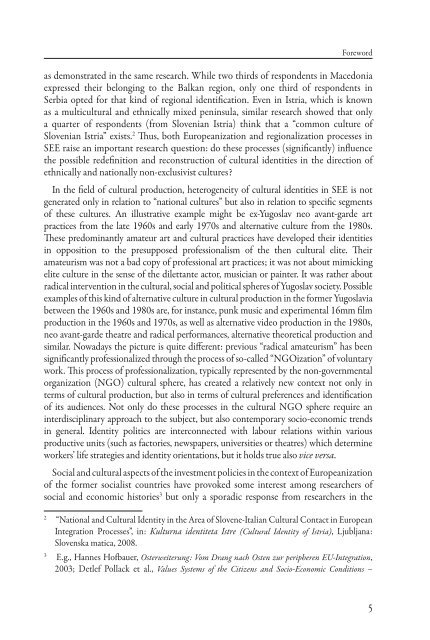Cultural Identity Politics in the (Post-)Transitional Societies
Cultural Identity Politics in the (Post-)Transitional Societies
Cultural Identity Politics in the (Post-)Transitional Societies
You also want an ePaper? Increase the reach of your titles
YUMPU automatically turns print PDFs into web optimized ePapers that Google loves.
Foreword<br />
as demonstrated <strong>in</strong> <strong>the</strong> same research. While two thirds of respondents <strong>in</strong> Macedonia<br />
expressed <strong>the</strong>ir belong<strong>in</strong>g to <strong>the</strong> Balkan region, only one third of respondents <strong>in</strong><br />
Serbia opted for that k<strong>in</strong>d of regional identification. Even <strong>in</strong> Istria, which is known<br />
as a multicultural and ethnically mixed pen<strong>in</strong>sula, similar research showed that only<br />
a quarter of respondents (from Slovenian Istria) th<strong>in</strong>k that a “common culture of<br />
Slovenian Istria” exists. 2 Thus, both Europeanization and regionalization processes <strong>in</strong><br />
SEE raise an important research question: do <strong>the</strong>se processes (significantly) <strong>in</strong>fluence<br />
<strong>the</strong> possible redef<strong>in</strong>ition and reconstruction of cultural identities <strong>in</strong> <strong>the</strong> direction of<br />
ethnically and nationally non-exclusivist cultures<br />
In <strong>the</strong> field of cultural production, heterogeneity of cultural identities <strong>in</strong> SEE is not<br />
generated only <strong>in</strong> relation to “national cultures” but also <strong>in</strong> relation to specific segments<br />
of <strong>the</strong>se cultures. An illustrative example might be ex-Yugoslav neo avant-garde art<br />
practices from <strong>the</strong> late 1960s and early 1970s and alternative culture from <strong>the</strong> 1980s.<br />
These predom<strong>in</strong>antly amateur art and cultural practices have developed <strong>the</strong>ir identities<br />
<strong>in</strong> opposition to <strong>the</strong> presupposed professionalism of <strong>the</strong> <strong>the</strong>n cultural elite. Their<br />
amateurism was not a bad copy of professional art practices; it was not about mimick<strong>in</strong>g<br />
elite culture <strong>in</strong> <strong>the</strong> sense of <strong>the</strong> dilettante actor, musician or pa<strong>in</strong>ter. It was ra<strong>the</strong>r about<br />
radical <strong>in</strong>tervention <strong>in</strong> <strong>the</strong> cultural, social and political spheres of Yugoslav society. Possible<br />
examples of this k<strong>in</strong>d of alternative culture <strong>in</strong> cultural production <strong>in</strong> <strong>the</strong> former Yugoslavia<br />
between <strong>the</strong> 1960s and 1980s are, for <strong>in</strong>stance, punk music and experimental 16mm film<br />
production <strong>in</strong> <strong>the</strong> 1960s and 1970s, as well as alternative video production <strong>in</strong> <strong>the</strong> 1980s,<br />
neo avant-garde <strong>the</strong>atre and radical performances, alternative <strong>the</strong>oretical production and<br />
similar. Nowadays <strong>the</strong> picture is quite different: previous “radical amateurism” has been<br />
significantly professionalized through <strong>the</strong> process of so-called “NGOization” of voluntary<br />
work. This process of professionalization, typically represented by <strong>the</strong> non-governmental<br />
organization (NGO) cultural sphere, has created a relatively new context not only <strong>in</strong><br />
terms of cultural production, but also <strong>in</strong> terms of cultural preferences and identification<br />
of its audiences. Not only do <strong>the</strong>se processes <strong>in</strong> <strong>the</strong> cultural NGO sphere require an<br />
<strong>in</strong>terdiscipl<strong>in</strong>ary approach to <strong>the</strong> subject, but also contemporary socio-economic trends<br />
<strong>in</strong> general. <strong>Identity</strong> politics are <strong>in</strong>terconnected with labour relations with<strong>in</strong> various<br />
productive units (such as factories, newspapers, universities or <strong>the</strong>atres) which determ<strong>in</strong>e<br />
workers’ life strategies and identity orientations, but it holds true also vice versa.<br />
Social and cultural aspects of <strong>the</strong> <strong>in</strong>vestment policies <strong>in</strong> <strong>the</strong> context of Europeanization<br />
of <strong>the</strong> former socialist countries have provoked some <strong>in</strong>terest among researchers of<br />
social and economic histories 3 but only a sporadic response from researchers <strong>in</strong> <strong>the</strong><br />
2<br />
“National and <strong>Cultural</strong> <strong>Identity</strong> <strong>in</strong> <strong>the</strong> Area of Slovene-Italian <strong>Cultural</strong> Contact <strong>in</strong> European<br />
Integration Processes”, <strong>in</strong>: Kulturna identiteta Istre (<strong>Cultural</strong> <strong>Identity</strong> of Istria), Ljubljana:<br />
Slovenska matica, 2008.<br />
3<br />
E.g., Hannes Hofbauer, Osterweiterung: Vom Drang nach Osten zur peripheren EU-Integration,<br />
2003; Detlef Pollack et al., Values Systems of <strong>the</strong> Citizens and Socio-Economic Conditions –<br />
5




